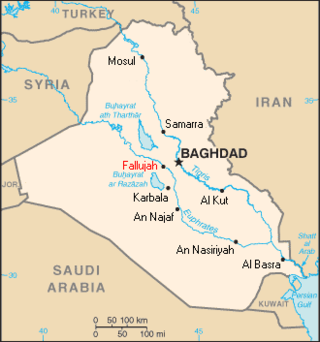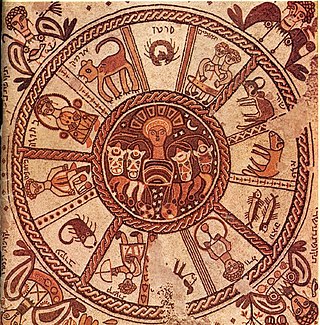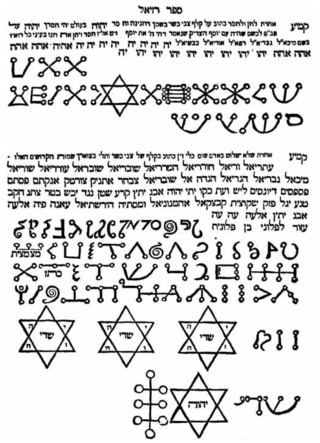Related Research Articles

Rabbinic literature, in its broadest sense, is the entire spectrum of rabbinic writings throughout Jewish history. However, the term often refers specifically to literature from the Talmudic era, as opposed to medieval and modern rabbinic writings, and thus corresponds with the Hebrew term Sifrut Chazal. This more specific sense of "Rabbinic literature"—referring to the Talmudim, Midrashim, and related writings, but hardly ever to later texts—is how the term is generally intended when used in contemporary academic writing. The terms mefareshim and parshanim (commentaries/commentators) almost always refer to later, post-Talmudic writers of rabbinic glosses on Biblical and Talmudic texts.

Abraham ben Meir Ibn Ezra was one of the most distinguished Jewish biblical commentators and philosophers of the Middle Ages. He was born in Tudela, Taifa of Zaragoza.

Saʿadia ben Yosef Gaon was a prominent rabbi, gaon, Jewish philosopher, and exegete who was active in the Abbasid Caliphate.
Sefer Yetzirah is the title of a book on Jewish mysticism. Early commentators, such as the Kuzari, treated it as a treatise on mathematical and linguistic theory as opposed to Kabbalah. The word Yetzirah is more literally translated as "Formation"; the word Briah is used for "Creation". The book is traditionally ascribed to the patriarch Abraham, although others attribute its writing to Rabbi Akiva. Modern scholars have not reached consensus on the question of its origins. According to Rabbi Saadia Gaon, the objective of the book's author was to convey in writing how the things of our universe came into existence. Conversely, Judah Halevi asserts that the main objective of the book, with its various examples, is to give to man the means by which he is able to understand the unity and omnipotence of God, which appear multiform on one side and, yet, are uniform.

Hai ben Sherira better known as Hai Gaon, was a medieval Jewish theologian, rabbi and scholar who served as Gaon of the Talmudic academy of Pumbedita during the early 11th century. He was born in 939 and died on March 28, 1038. He received his Talmudic education from his father, Sherira ben Hanina, and in early life acted as his assistant in teaching. In his forty-fourth year he became associated with his father as "av bet din," and with him delivered many joint decisions. According to Sefer HaKabbalah of Rabbi Abraham ben David (Ravad), he was the last of the Geonim.

Isaac Israeli ben Solomon, also known as Isaac Israeli the Elder and Isaac Judaeus, was one of the foremost Jewish physicians and philosophers living in the Arab world of his time. He is regarded as the father of medieval Jewish Neoplatonism. His works, all written in Arabic and subsequently translated into Hebrew, Latin and Spanish, entered the medical curriculum of the early thirteenth-century universities in Medieval Europe and remained popular throughout the Middle Ages.

Astrology has been a topic of debate among Jews for over 2000 years. While not a Jewish practice or teaching as such, astrology made its way into Jewish thought, as can be seen in the many references to it in the Talmud. Astrological statements became accepted and worthy of debate and discussion by Torah scholars. Opinions varied: some rabbis rejected the validity of astrology; others accepted its validity but forbid practicing it; still others thought its practice to be meaningful and permitted. In modern times, as science has rejected the validity of astrology, many Jewish thinkers have similarly rejected it; though some continue to defend the pro-astrology views that were common among pre-modern Jews.
Dunash ibn Tamim was a Jewish tenth century scholar, and a pioneer of scientific study among Arabic-speaking Jews. His Arabic name was أبو سهل Abu Sahl; his surname, according to an isolated statement of Moses ibn Ezra, was "Al-Shafalgi," perhaps after his (unknown) birthplace. Another name referring to him is Adonim.
Azriel ibn Menahem ibn Ibrahim al-Tarās also known as Azriel of Girona was the founder of speculative Kabbalah and the Gironian Kabbalist school. He is known for implementing Neoplatonic thought into mainstream kabbalistic tradition.
Hebrew astronomy refers to any astronomy written in Hebrew or by Hebrew speakers, or translated into Hebrew, or written by Jews in Judeo-Arabic. It includes a range of genres from the earliest astronomy and cosmology contained in the Bible, mainly the Tanakh, to Jewish religious works like the Talmud and very technical works.

Sefer Raziel HaMalakh is a grimoire of Practical Kabbalah from the Middle Ages written primarily in Hebrew and Aramaic. Liber Razielis Archangeli, its 13th-century Latin translation produced under Alfonso X of Castile, survives.
The Scrolls of Abraham are a part of the religious scriptures of Islam. These scriptures are believed to have contained the revelations of Abraham received from the God of Abrahamic religions, which were written down by him as well as his scribes and followers.
Tobiah ben Eliezer was a Talmudist and poet of the 11th century, author of Lekach Tov or Pesikta Zutarta, a midrashic commentary on the Pentateuch and the Five Megillot.
Samuel ben Hofni was the gaon of Sura Academy in Mesopotamia ("Babylonia") from 998 to 1012.

Shabbethai Donnolo was a Graeco-Italian Jewish physician and writer on medicine and astrology.

The Mekhilta of Rabbi Shimon ben Yochai is midrash halakha on Book of Exodus from the school of Rabbi Akiva attributed to Shimon bar Yochai. No midrash of this name is mentioned in Talmudic literature, but Nachmanides (d.1270) refers to one which he calls either Mekhilta de-Rabbi Shimon ben Yochai, Mekhilta Achǝrita de-Rabbi Shimon, or simply Mekhilta Acheret. Todros ben Joseph Abulafia (d.1285) also refers to Mekhilta de-Rabbi Shimon ben Yochai.

Nathan ben Abraham, known also by the epithet President of the Academy in the Land of Israel, was an 11th-century rabbi and exegete of the Mishnah who lived in Ramla, in the Jund Filastin district of the Fatimid Caliphate. He was the author of the first known commentary covering the entire Mishnah.
Judah ibn Balaam was an Andalusian rabbi of the eleventh century.
Rabbi Meir ben Solomon Abi-Sahula also known as ben Sahula or ibn Sahula was a 13th century Spanish kabbalist and Sephardic tosafist. He is known for his final commentary on Sefer Bahir, which he published under the pseudonym "Or HaGanuz".

Astrology in Jewish antiquity is the belief that celestial bodies can influence the affairs of individuals and of entire nations upon the earth. This involves the study of the celestial bodies' respective energies based on recurring patterns that change by the hour, by the week, month, year or by several years. In each of these time categories one of the seven planetary spheres, or what are known as the seven classical planets: the Sun, Venus, Mercury, the Moon, Saturn, Jupiter, or Mars, along with the month's current Zodiac constellation, come into play and influence the sublunary world. At times, it involves a complex combination of several of these factors working together. In Judaism this belief is expressed by the biblical affirmation: "Do you know the laws of heaven / Or impose its authority on earth?" (Job 38:33), from which statement the Sages of Israel have inferred, "There is no single herb below without its corresponding star above, that beats upon it and commands it to grow."
References
- 1 2 Sefer Yetzirah 6:1-2, Sefaria
- ↑ Andrew Scharf, The Universe of Shabbetai Donnolo, (Warminster, England, Aris & Phillips LTD, 1976), pp. 11-34
- ↑ Commentaire sur le Sefer Yetsirah, translated by Mayer Lambert (Lagresse: Verdier, 2001), p. 73
- ↑ A.C. Sparavigna (2014). The Creation of the World in the Sefer Yetzirah. In: INTERNATIONAL JOURNAL OF SCIENCES, vol. 3 n. 5, pp. 11-17. - ISSN 2305-3925
- ↑ Ibn Ezra on Isaiah, Sefaria
- ↑ HaGra on Sefer Yetzriah 6:1:7, Sefaria